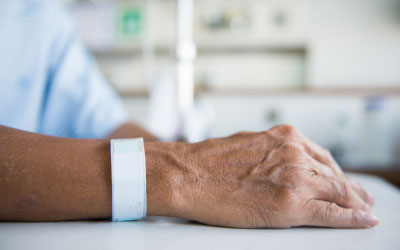Acute Lymphoblastic Leukemia
Acute lymphoblastic leukemia (acute lymphocytic leukemia or ALL) is a cancer of the bone marrow that can spread quickly to blood cells. It can develop at any age, but it’s most common in children between ages three and five. With treatment, the condition can be cured in most children and many adults.
What is acute lymphoblastic leukemia (ALL)?
Acute lymphoblastic leukemia causes your bone marrow (spongy tissue in bones) to make too many immature white blood cells (lymphoblasts). These abnormal cells crowd out healthy red and white blood cells and platelets in the blood and bone marrow, making it difficult for the body to fight infection and disease.
The word “acute” means the disease progresses quickly and can be severe. ALL can spread quickly to the lymph nodes, liver, spleen, brain, spinal cord, and testicles. Left untreated, it can become life-threatening.
The most common childhood leukemia and cancer, ALL typically occurs before age 15. In most cases, acute lymphoblastic leukemia in children can be cured.
Acute lymphoblastic leukemia in adults is less common and more difficult to manage. With treatment, the condition in some adults can be cured.
L ymphoblastic leukemia facts and stats
- About 54% of acute lymphoblastic leukemia occurs in children and teens under age 20.
- It is most common before age 15 and after 50.
- In 2022, it is estimated that there will be 6,660 new cases of acute lymphoblastic leukemia.
For survival rates, view our leukemia statistics webpage.
Causes and risk factors of lymphoblastic leukemia
Researchers believe acute lymphoblastic leukemia occurs due to genetic mutations (changes) that affect blood cell production. The exact cause of these changes is not known.
Risk factors that may increase your odds of developing ALL include:
- Previous cancer treatment with chemotherapy or radiation
- Exposure to very high levels of radiation, such as a nuclear reactor accident
- Genetic disorders, including Down syndrome, neurofibromatosis type 1 (NF1), and Fanconi anemia
Symptoms of lymphoblastic leukemia
Some children and adults with acute lymphoblastic leukemia may not experience symptoms. Many symptoms can feel like the flu, but don’t improve with time.
Symptoms may include:
- Easy bruising
- Excessive bleeding (nosebleeds, bleeding gums, etc.)
- Fever
- Frequent infections
- Lumps (swollen lymph nodes) in the neck, underarms, groin, or stomach
- Pale skin
- Shortness of breath
- Tiny red dots under the skin (petechiae)
- Weakness or fatigue
Types of lymphoblastic leukemia
The World Health Organization classifies acute lymphoblastic leukemia into two main groups:
- B-cell lymphoblastic leukemia/lymphoma: Starts in immature cells that ordinarily develop into B-cell lymphocytes. B-cell ALL is the most common subtype.
- T-cell lymphoblastic leukemia: Starts in immature cells that ordinarily develop into T-cell lymphocytes. T-cell ALL is less common.
Diagnosing lymphoblastic leukemia
To diagnose acute lymphoblastic leukemia, your doctor performs a thorough physical exam and checks your body for swollen lymph nodes (small glands that help your body fight infection). Your doctor also asks about your health history and family health history.
Tests for ALL include:
- Blood tests: These tests can show the extent of cancer and if you have any signs of infection. Blood tests measure levels of white and red blood cells, the amount of inflammation in the body, and liver and kidney function.
- Bone marrow biopsy and aspiration: Doctors use these tests to look for leukemia cells in the bone marrow. They use thin, hollow needles to remove small samples of bone marrow and bone tissue for analysis.
- Imaging: These tests produce detailed images of the body to help determine the cancer type and its severity. They also show the location of affected lymph nodes and tumors. Imaging tests may include X-ray, CT scan, and MRI.
- Genetic tests: ALL may be due to genetic changes (mutations). These tests can detect those changes and help guide treatment.
- Lumbar puncture (spinal tap): Your doctor uses a needle to remove a small amount of cerebrospinal fluid (the fluid surrounding your brain and spinal cord). Results show whether the disease has spread into fluid around the brain or spinal cord.
Treatments for lymphoblastic leukemia
Treatment options for acute lymphoblastic leukemia depend on your overall health and how well you respond to treatment. ALL is not divided into stages, which doctors use to describe the extent of cancer in other forms of the disease.
Treatment plans vary for children and adults. Children typically receive treatment from a team of pediatric doctors who specialize in treating childhood cancer. Your doctor works with you to determine treatment based on how the cancer formed, genetic changes (mutations), and other factors.
Options for children and adults may include:
- Chemotherapy: These drugs destroy cancer cells. You receive chemotherapy drugs through an injection in the vein or in pill form. Children may receive higher doses of chemotherapy drugs than an adult because their bodies usually tolerate it better.
- Radiation therapy: Radiation uses focused beams of energy to target and kill cancer. Doctors carefully plan treatments to pinpoint the location of the cancer and reduce harm to nearby healthy tissue. Radiation can be effective if cancer has spread to other parts of the body, such as the brain, spinal cord, or testicles.
- Targeted therapy: Targeted drugs and other substances can often stop the growth of cancer cells or kill them while minimizing harm to surrounding healthy tissue.
- Stem cell transplant (bone marrow transplant): The doctor extracts damaged stem cells (blood-forming cells in the bone marrow) and replaces them with healthy cells from a donor or a patient’s own cells. Doctors often combine stem cell transplants with chemotherapy or radiation. Stem cell transplant is typically an option for children only if other treatments aren’t successful.
- Immunotherapy: These drugs help your immune system fight off cancer. Immunotherapy treatments include antibodies, drugs that help your body develop antibodies, and targeted therapies that block cancer cells from multiplying. CAR T-cell therapy, which uses lab-grown immune cells to attack cancer, is an FDA-approved treatment for adults whose cancer either doesn’t respond to treatment or returns. CAR T-cell therapy is available to children only through clinical trials.
- Clinical trials: Clinical trials available at some medical centers may give eligible patients access to promising treatments not widely available.
Helpful resources
Support can make a difference when you or your child faces a diagnosis of acute lymphoblastic leukemia. We offer peer support programs to connect you with others who understand the challenges of ALL. We have an online support community and a mentoring program. We also offer a directory of resources to help patients, parents, and caregivers.



